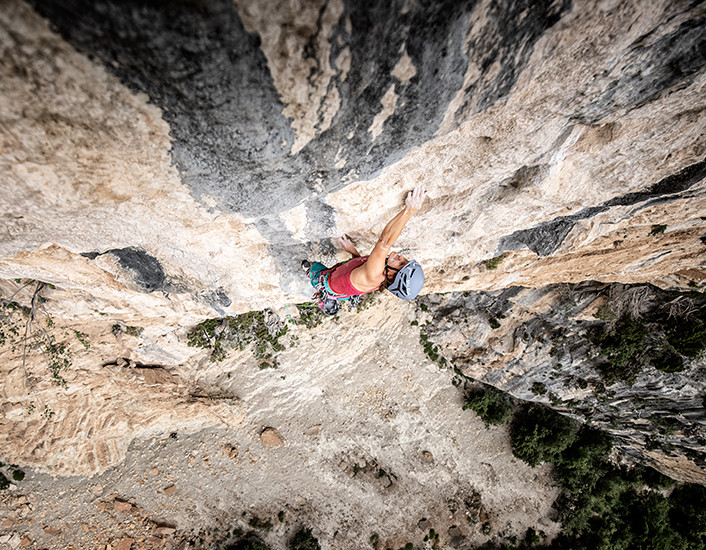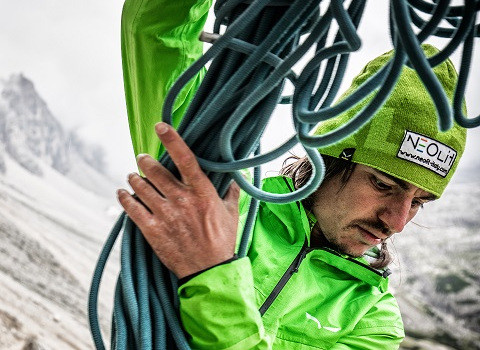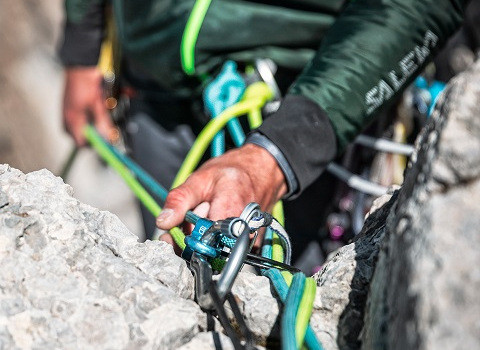expert advice / alpine climbing
TYPES OF CLIMBING
1. Via ferrata - What’s a via ferrata?
South Tirol, Alto Adige and the Veneto in Italy have some of the best vie ferrate in the world (literally ‘iron ways’). These mountain routes are equipped with fixed ladders, steel cables, bolted anchors and suspended bridges to allow access to climbers and hikers with a good level of fitness, but not necessarily much experience of placing mobile protection such as nuts, slings and friends, or belays and rope management. However, although they don’t have the risks associated with unprotected scrambling and climbing, some ferratas run right to the top of high mountains and experience is still essential. The first Via Ferrata in Cortina d’Ampezzo, Ra Šàra del Minighèl (Ladin for Minighel’s Ladder) is one of the oldest ferratas in the Dolomites. Created by a local blacksmith in 1907, it leads eighty metres up an exposed rockface at Majarié (el Souto del Majarié) in the Val Travenanzes area. This area was also the scene of some of the most intense fighting in World War I, when the via ferratas proved handy for moving and supplying troops along the Italo-Austrian border. There are still many ruins, trenches, caves and tunnels excavated by the soldiers.
2. What is Sport Climbing?
For many people, gym climbing is a means in itself. However, in reality it’s just the start of the journey. Indoor facilities provide a convenient environment to practice, but climbing is ultimately an outdoor sport – where other factors come into play, such as rope management, weather conditions, ethics, the nature of the rock itself and the natural surroundings.
Most sport-climbs outdoors are generally lead climbs. The lead climber places quickdraws (two non-locking carabiners connected with webbing) in preplaced bolts along the route, clips in the rope as they ascend and then builds an anchor at the top. At some outdoor crags, it is also possible to hike or climb to the top of the bolted anchor, set the rope, then sport top rope the routes. We highly recommend that you learn how to clean a top rope anchor safely too. Top roping is a good way to boulder out sequences or do laps to build up aerobic endurance. Sport climbing mainly involves high-intensity movement and emphasis on the physical aspect or difficulty of the climb rather than the destination or summit. Sport climbing can be single pitch, which is belayed from the ground or multi-pitch.
3. What is Trad Climbing?
Trad (traditional) climbing stands for adventure and exploration. It involves climbing outdoors with removable gear to protect you from falling. The last member of the party cleans the route, removing the protection as they ascend. As you place your own pro (such as slings, nuts and cams), there is a high emphasis on the mental challenge, self-sufficiency and individual responsibility. Traditional climbing requires technical knowledge of placing gear, climbing anchors and rope management. And seeing that there are no bolts and you take your gear with you, you climb leaving no trace – especially if you try to use as little chalk as possible.
Sport vs. Trad
In many ways, sport climbing is more accessible than traditional rock climbing, both in terms of equipment and the skills required. Sport climbers don’t need to carry and place their own gear, but instead clip into fixed bolts. This allows the lead climber to progress upward without the hassle of carrying a full rack of protection and looking for gear placements, as you do in trad climbing. Skills learnt at the wall can be easily transferred to sport climbing, often at nearby, accessible rock crags. With sport climbing, it’s not unusual to climb to your limit and take a fall, often repeatedly, as you try to work out a sequence. This is pretty different to trad climbing where you generally want to be more careful about falling on an anchor.
5. What is Ice Climbing?
Rime ice, hoar frost and frozen waterfalls. Ice climbing is one of the most intense forms of climbing going. The Dolomites are well known for summer climbing; however, the winter climbing is equally impressive. There are icefalls everywhere, of all grades and all lengths, set in some of the most beautiful dramatic scenery in Europe, such as Val Gardena and Val di Fassa.
Top tips for ice climbing:
- Leading an ice climb is not leading a sport climb. A fall could quickly result in serious injury. Get the right mind-set and focus.
- There’s no such thing as “easy ice climbing terrain”. Whether the ice is steep or low-angled, your fall hazard is pretty much the same. Having said that, at some point you will take a fall. Make sure you get good gear in. You could also practice taking falls on a top rope.
- Don’t forget to breathe. Find out what works best for you to help you stay relaxed, so you can climb more efficiently and make better use of your reserves, for example by less over gripping of your tools.
- Scope out your route in advance, decide on your tactics, i.e. where the crux is, where you can rest, where you can place gear. Check the guidebooks and talk to the locals about the conditions.
- Conditions are all important. Big changes in temperature, including severe drops in temperature, can make icefalls brittle and unstable. Slower cooling, spread over several days and stable cold spells are preferable. This is just theory though. What you need is experience gained through practice.
- Slow it down. Fast is not cool. Place your feet. Stay solid and locked in. Ice climbing is about control, not fighting the pump. Ensure each tool placement is bomber. Move solidly, and with good technique.
- Don’t be over optimistic. Accurate self-assessment see you further. And help keep you safe.
- Climbing down is better than falling down. If you’re pumped, you can always clip a sling into your tool or screw for a rest. Better still, down climb to a ledge or somewhere you can stop, shake out and regroup. Pushing on expecting things to get better is generally a bad idea.
- Be respectful. Ice climbing should be a safe and enjoyable experience for everyone. Falling ice from other climbers is a normal part of ice climbing – if it hits you, you might get knocked off or seriously hurt. Keep away from other climbers.
- Find someone you can learn from – a mentor or instructor. Toprope, do laps and build up your skills and experience.
- Learn how to stay warm, but without overheating, by using winter layering.
- Fear is bad. Fun is good. Play it safe. If you’re feeling the fear, it’s probably a sign that you’re out of your depth.
4. What is Alpine Climbing?
Alpine climbing, like mountaineering, can be very physically and mentally demanding, with long hours spent moving up and down a mountain in difficult conditions, climbing with a pack. A high degree of technical skill is required, such as rope management and rescue technique. The sense of accomplishment upon completing a route make any hardship worthwhile.
Moving from weekend cragging to long, alpine routes is a big step up, even for strong and competent climbers.
Building up your experience, using good judgment and trusting your instincts are the name of the game. Packing light, moving quickly and looking after your partners is key. Don’t be afraid to pull on gear to move through a difficult section. Sometimes, you might have to ditch your free climbing ethics, to make it to the top before the sun goes down or conditions deteriorate. Be humble, be conservative – climb well within your ability – and know how to bail with grace. It takes skill and good judgement to abandon a route in time, even if it means leaving gear behind. Oh, and don’t forget your helmet – or your headlamp.
Related Topics
WHAT CLIMBING GEAR DO YOU NEED?
Climbing covers a whole load of different disciplines, all with their specific types of gear, techniques and training.
MOUNTAINEERING SKILLS & TECHNIQUES NEEDED
The essential technical skills needed for mountaineering take some time to learn.
HOW TO LEARN ALPINE CLIMBING
Alpine climbing means mountain climbing in high, often glaciated areas that can include scrambling and technical climbing in snow, rock or mixed terrain.





